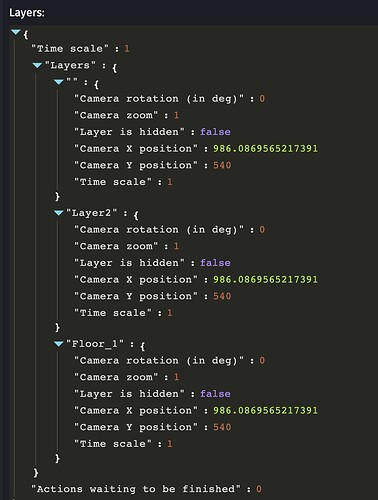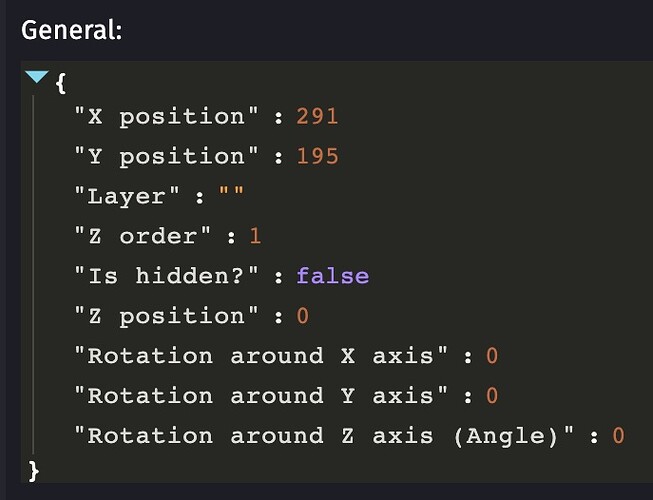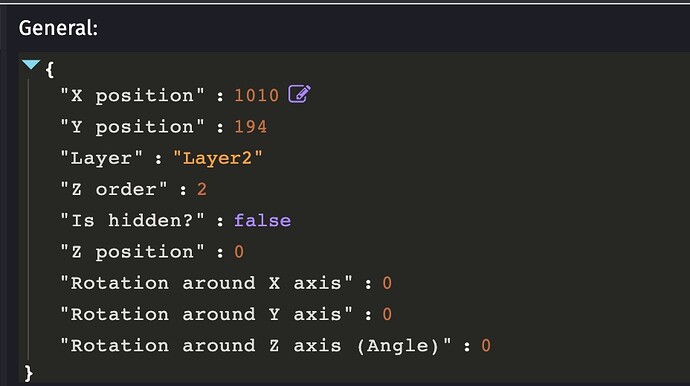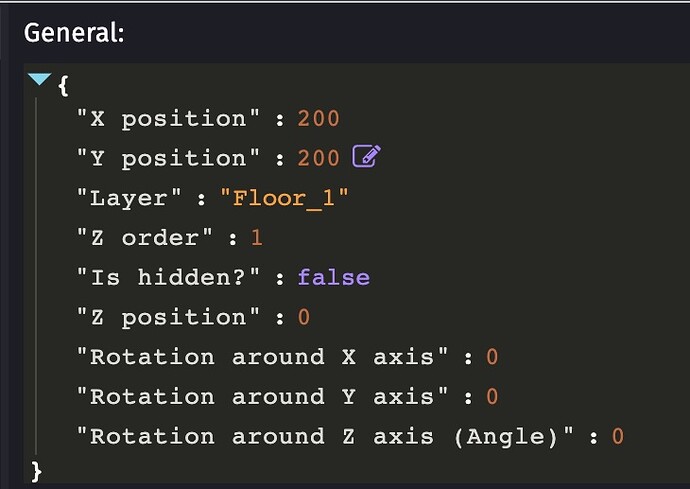Before proceeding, please use the forum search feature at the top of the page to check if your question has already been answered.
How do I…
I can create objects in javascript and assigned them to existing layers.
It works.
But I’m unable so far to create a layer in javascript and assigned objects to it.
The layers are created, objects are created and assigned to it, but they do not show up on the screen.
If I assigned the objects to layers defined from the GUI, it does work.
So, it’s not an object problem.
What is the expected result
I expect the object to appear on the screen for this new layer created in JS.
What is the actual result
Objects and Layers show up in the debugger, but not on the screen.
Related screenshots
Code below.
runtimeScene.setBackgroundColor(100,100,240);
//
// One Cube, one layer, on/off
//
console.log("Once Cube script started...");
const scene = runtimeScene;
const startX = 200;
const startY = 200;
const startZ = 0;
console.log("Building pyramid layers...");
// FIXED: Access camera through the default layer
const baseLayer = scene.getLayer("");
if (!baseLayer) {
console.error("CRITICAL: Base layer not found. Cannot build pyramid.");
return;
}
console.log("Base layer found. Proceeding to build layers.");
// const layerName = `Floor_1`;
const layerName = `Layer3`;
// Check if the layer already exists to avoid re-creating it.
if (!scene.hasLayer(layerName)) {
console.log(`Layer '${layerName}' does not exist. Creating it...`);
// Create new layer with proper structure
const layerData = {
name: layerName,
visibility: true,
effects: [],
cameras: [],
ambientLightColorR: 200,
ambientLightColorG: 200,
ambientLightColorB: 200,
isLightingLayer: false,
followBaseLayerCamera: true
};
scene.addLayer(layerData);
console.log(`Layer '${layerName}' created.`);
}
// FIXED: Proper object creation in GDevelop
try {
// Method 1: Direct object creation (most common)
const newCube = scene.createObject("Cube");
if (!newCube) {
console.error("Failed to create cube object. Make sure 'Cube' object exists in your scene.");
return;
}
console.log("Cube object created successfully");
// Set the layer
newCube.setLayer(layerName);
// Set position immediately after creation
const posX = startX;
const posY = startY;
const posZ = startZ;
newCube.setPosition(posX, posY);
newCube.setZOrder(1)
// Try different Z-setting methods
if (typeof newCube.setZ === 'function') {
newCube.setZ(posZ);
} else if (typeof newCube.setZOrder === 'function') {
newCube.setZOrder(posZ);
}
// Set color/tint
const r = Math.min(255, 50);
const g = Math.min(255, 90);
const b = Math.min(255, 120);
// Try different color methods
if (typeof newCube.setColor === 'function') {
newCube.setColor(`${r};${g};${b}`);
} else if (typeof newCube.setTint === 'function') {
newCube.setTint(`${r};${g};${b}`);
} else if (typeof newCube.setColorTransform === 'function') {
newCube.setColorTransform(r/255, g/255, b/255, 1);
}
// Make sure object is visible and active
if (typeof newCube.hide === 'function') {
newCube.hide(false);
}
if (typeof newCube.activateBehavior === 'function') {
newCube.activateBehavior("", true);
}
console.log(`Created cube at position (${posX}, ${posY}, ${posZ})`);
} catch (error) {
console.error("Error creating cube:", error);
}
// FIXED: Debugging info with correct API calls
console.log("=== DEBUGGING INFO ===");
try {
// Get all objects in the scene
// Replace 'MyObject' with your actual object name
const allObjects = runtimeScene.getObjects("Cube");
console.log("Total objects named Cube:", allObjects.length);
// List all objects and their positions
for (let i = 0; i < allObjects.length; i++) {
const obj = allObjects[i];
console.log(`Object ${i}: ${obj.getName()} at (${obj.getX()}, ${obj.getY()})`);
}
// Alternative way to check for specific object types
const cubeObjects = scene.getObjects("Cube");
console.log("Cube objects found:", cubeObjects.length);
} catch (debugError) {
console.error("Error in debugging section:", debugError);
}
console.log("Pyramid generation complete.");
console.log("This runs only once");
Project files (optional)
N/A



